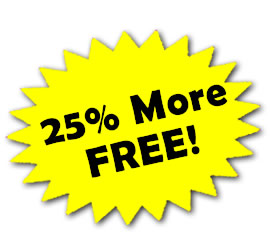What Pricing Strategy Beats Discounts?
 If you want to sell more product by running a sale, which would make more sense: advertising “price cut 33%” or “50% more” product? Functionally, the two are the same level of discounting. Researchers at the University of Minnesota found, though, that a “50% bonus pack” sold 71% more than a “35% discount,” even though the latter is a slightly lower price per unit.
If you want to sell more product by running a sale, which would make more sense: advertising “price cut 33%” or “50% more” product? Functionally, the two are the same level of discounting. Researchers at the University of Minnesota found, though, that a “50% bonus pack” sold 71% more than a “35% discount,” even though the latter is a slightly lower price per unit.
Our Brains Are Bad at Math
As Barbie famously said, “Math is hard.” Both male and female brains aren’t good at automatically determining which deal is best, which explains why a “50%” number looks more attractive than “35%” even when mathematically it is actually worse. The researchers call this “base value neglect” – in essence, we look at the percent without paying attention to the number to which the percent applies! (The paper appears in the Journal of Marketing and is titled When More Is Less: The Impact of Base Value Neglect on Consumer Preferences for Bonus Packs over
Price Discounts.)
Maximize Your Percent
The first takeaway is that you should always try to structure a promotion in terms of the biggest percent you can. (A “50% more” type approach may have the added benefit of carrying through more product.)
The paper notes that stacked discounts are also overestimated by consumers. So, “Take 25% more off” a price that is “discounted 25%” will seem larger than if the price is described as a “43% discount.”
Don’t Forget FREE!
Other research has shown that the word “FREE!” is a significant motivator for consumers – see The Power of FREE!. The Minnesota researchers were aware of this, so they eliminated the word “free” from their bonus offers to avoid distorting the effects of the subjects not paying attention to the base value.
You, on the other hand, should use FREE! whenever you can. Instead of “25% Bonus” or “25% More,” use “25% More FREE!” to maximize sales.
In short, combine the biggest percentages with the word FREE! and you’ll sell far more product than an equivalent discount.

Roger,
Pricing strategy is never intuitive, which is why testing is a requirement right? 25% more FREE, that’s kind of weird, which is good, so I’ll try it.
Joe, I agree about testing. I should probably put “be sure to test instead of assuming this will work” at the end of every post.
Roger
Simple but efficient trick 🙂
25% more free doesn’t mean anything but it works
Actually, Jim, it should mean “25% more free.” 🙂
Roger
Great article, Roger. That stacked discount tactic really nails the sweet spot of the shopper in search of the best deal.
If you have a moment go to the end of the article in the Journal of Marketing and see the brief story on a “convenience check” offer from a credit card company. That’s anonther eye opener! There’s a couple of questions afterwards. See if you can get them right.
Best wishes,
Jay
Kind of a “but wait, there’s more!” strategy. I’ll check out the link.
Roger
I’ve certainly seen Software as a Service using the “Download now for Free!” more than any other industry.
Unfiortunately many of them don’t tell you that it’s free for only 30 days but I guess that’s potentially another blog post as to the psychology of being deceived in relation to sales.
You made me smile when I read something about Math. I am one of the haters of math and definitely I hate numbers. Anyway, using “FREE” word can attract more customers.
I actually noticed the power of FREE in practice but it’s cool to see hear about some theoretic backing behind it. I didn’t realize it’s effect is almost systematically effective. The advice on how numbers are perceived is great. Going to put all the advice here in practice, let’s kill Christmas.
Yes, the word free does work sometimes, but you have to keep in mind that most of the times customers are looking for your product when they visit your site and they already want to buy something so telling them that you they will get 25% more free of something won’t make them necessarily buy more because they get free stuff, they will probably purchase up until the amount they were originally looking for and then next time they want to buy the same thing, they will then come back to your site to buy and will become return customers.
I agree Carl, that free does not work to all, it can be a motivator to maximize sales. But we must also consider the target group around and their willingness to pay, let’s also be mindful of our competition or the variable and fixed costs of our products.